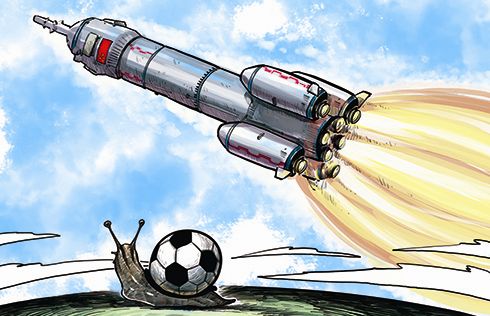More required to put the beauty back in the game
 |
|
Players fights for the ball during their FIFA World Cup 2018 qualifying match between China and Uzbekistan in Tashkent, Uzbekistan, Oct 11, 2016. China lost the match 0-2. [Photo/Xinhua] |
After being beaten by Uzbekistan on Tuesday night in the latest round of Asia's World Cup qualifiers, the Chinese men's national soccer team, with just one point from four games, has hardly any hope of playing in the finals in Russia in 2018.
Miracles sometimes do happen on the pitch, but what the Chinese players have displayed so far in terms of their skills, valor and even understanding of the sport has made even the most optimistic fan lose heart that their performance will improve in the foreseeable future.
The lamentable performance of the Chinese soccer team is a slap in the face for those who for decades have sought a short-cut route to soccer success, rather than seeking success from the grassroots up.
Huge amounts of money have been spent hiring foreign star players and high-profile coaches, drumming up a superficial boom for the domestic professional league, which nonetheless has been notorious for scandals. Many players, referees and officials have been put in jail for match rigging and other crimes.
And little progress has been made in providing kids with more soccer fields and school pitches, so as to cultivate talented young players and building an environment conducive to the healthy development of the grassroots game.
It is estimated that China's soccer population remains a meager 25,000 players, with only 8,000 active registered professionals. In comparison, the number of youth players in Japan surpasses 1 million.
A recent under-11 scandal in Guangzhou, South China, in which a team lost 25-2 in a rigged match, also shows the urgency of cleaning up the youth game.
Without an orderly game for all age groups, especially youngsters, turning China into a soccer power will be like building a castle in the air.
Now the government has drafted an ambitious plan for development of the game in the country, with the aim of increasing its soccer playing population to 50 million by 2020 and having one soccer pitch for every 10,000 people by 2030.
This may help the nation achieve its goal of popularizing the sport but more important is cultivating a spirit of professionalism and fair play to root out the problems that have plagued the game in the past.
Equally important is the awareness that China has long passed the stage where it needs to spruce up its national image with success in one sport. Fans and officials should come to terms with reality and start to see soccer as just one of hundreds of sports that make people healthy and happy.



















